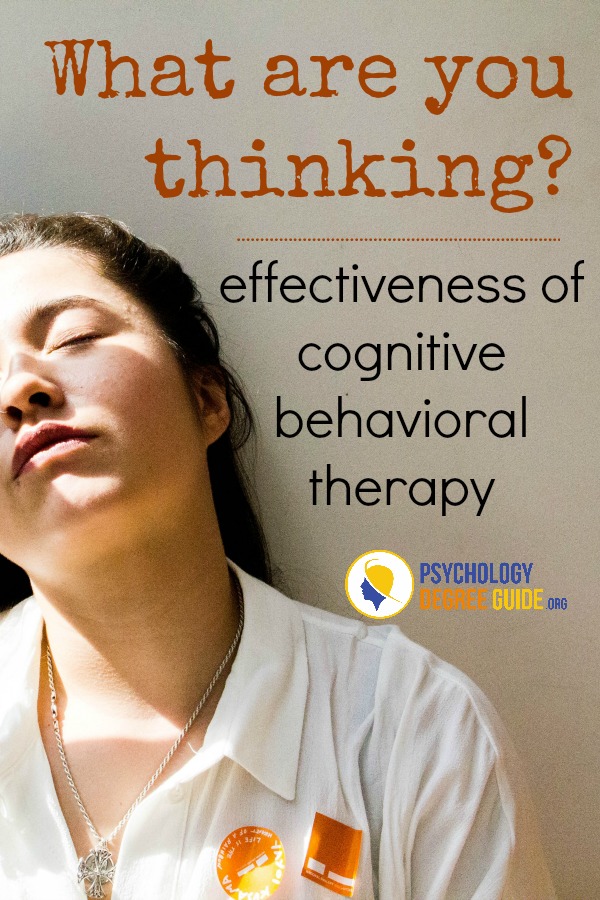Cognitive Behavioral Therapy 101
- May 25, 2016
- Posted by: Administrator
- Category: Psychology Explained,

Updated on Jan 30, 2021
Almost everyone knows someone who has spent years in counseling, week after week after week, seemingly throwing away thousands of dollars, but still not seeming to get any healthier. Yet we may also know others who have spent a few short months in counseling and seem to be happier and healthier. What’s the difference? Did the first person just have a “bad” counselor and the second a “good” one?
Sponsored School(s)
Probably not—though obviously some counselors are better than others. The difference may be that one type of psychotherapy is better (in other words, more effective) than others.
One form that appears to be highly effective for many people is Cognitive Behavioral Therapy (CBT), a form of counseling based on the idea that our thoughts cause our feelings and behaviors, not external things, like people, situations, or events.
What is an example of cognitive behavioral therapy?
Here’s an example: two people are considering opening a new business. They both read an article saying half of all new businesses fail in the first year. One thinks, “Wow! This sounds challenging, but means less competition for me” and feels happy. Another person thinks, “This sounds challenging. I don’t think I can do it” and feels discouraged. It’s not the situation that affects how they feel, but rather their thoughts in that situation.
What are the goals of cognitive behavioral therapy?
The benefit of CBT is that we can change the way we think in order to feel or act better even if the situation does not change. The goals of Cognitive Behavioral Therapy include clients being able to:
- Take control of their own behavior.
- Realize how they allow themselves to get stuck in unhealthy thought patterns.
- Make healthy choices in very difficult and challenging situations.
- Feel confident in making healthy choices.
- Stay calm and respond appropriately in difficult situations.
- Accept that they can make good choices and change their lives for the better.
What happens in a CBT session?
A CBT therapist may help clients complete a list of problems that they want to address. In addition, the clients develop realistic goals that are flexible and constantly under review. Clients take an active part in therapy, and this is what makes it so effective.
Often, clients plan with their therapist some “therapy tasks” or “homework” between sessions. The average length of treatment is 16 sessions, though that varies.
What is cognitive behavioral therapy used for?
There are thousands of studies on the types of mental health issues best suited for CBT. However, it is generally accepted that CBT works best with the following issues:
- Depression
- Panic Disorder
- Generalized anxiety disorder
- Agoraphobia
- Specific phobias
- Obsessive compulsive disorder
- Post traumatic stress disorder
- Bulimia
- Personality disorders
- Anger management
- Habit disorders
- Pain
- Chronic fatigue
CBT isn’t for everyone. There are some mental health issues that are resistant to CBT and may require more extensive psychotherapy and/or the use of medications as a part of a comprehensive treatment plan.
References
- The National Association of Cognitive-Behavioral Therapists — A very helpful site with consumer and professional information related to CBT, as well as an online bookstore and additional resources. Retrieved 6 April 2010.
- Academy of Cognitive Therapy — Retrieved 6 April 2010.
- Rational Thinking Score — A free web site that assesses your thinking and provides recommendations based on your responses. Retrieved 6 April 2010.
- Chojnacka, M. (2009). Cognitive-behavior therapy for late-life generalized anxiety disorder: literature overview. Psychiatr Pol. 43(5), 557-69.
- Butler, A.C., Chapman, J.E., Forman E.M., & Beck, A.T. (2006). The empirical status of cognitive-behavioral therapy: A review of meta-analyses. Clinical Psychology Review, 26, 17-31.
- Oei, T. P. S., Llamas, M., & Devilly, G.J. (1999). The efficacy and cognitive processes of cognitive behaviour therapy in the treatment of panic disorder with agoraphobia. Behavioural and Cognitive Psychotherapy, 27, 63-88.







